December 2025

The global infertility treatment market size is calculated at USD 1.70 billion in 2024 and is expected to be worth USD 3.65 billion by 2034, expanding at a CAGR of 7.9% from 2024 to 2034. The desire for parenthood has driven a booming market in infertility treatments.
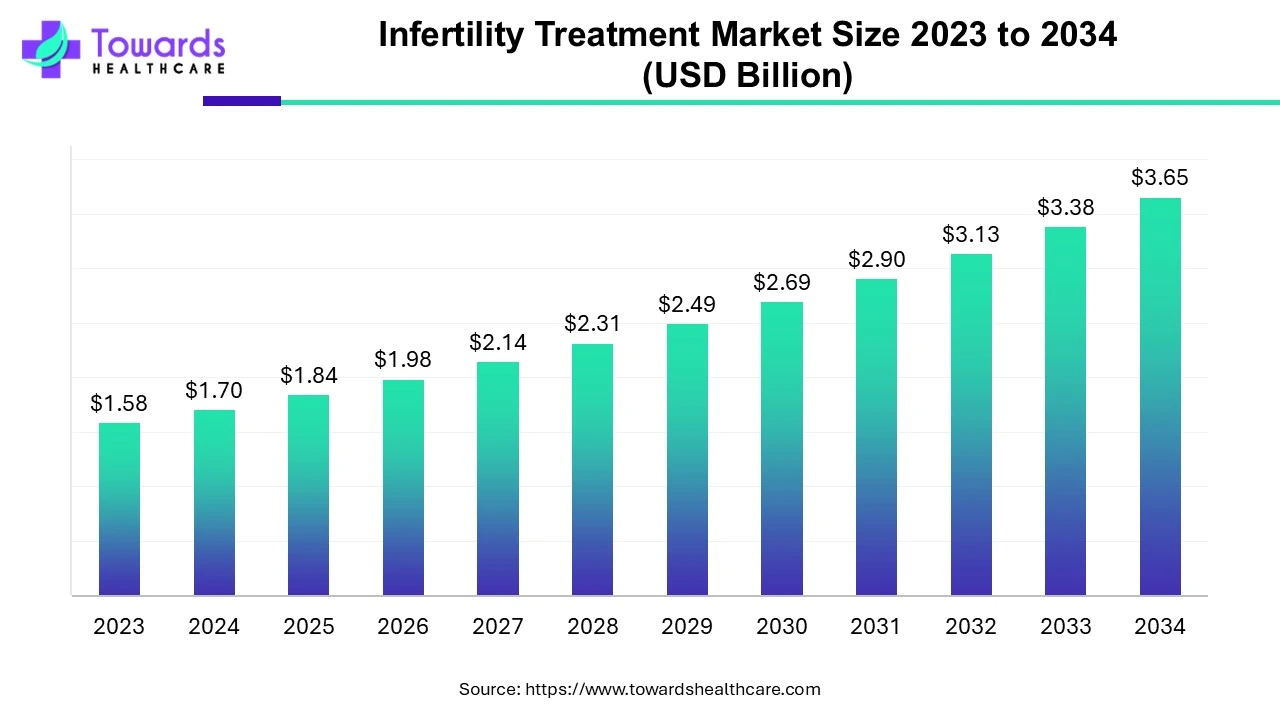
As per the report, the Centers for Disease Control and Prevention estimates that in the United States, there were about 238,126 people who went to fertility clinics. These clinics did 413,776 assisted reproductive technology (ART) cycles. The primary type of ART is in vitro fertilization (IVF). From these treatments, 91,906 live births happened, with 97,128 babies born alive.
In 2022, the National Library of Medicine reported that about 85% of couples who can't get pregnant have a reason behind it. The most common reasons are problems with ovulation, issues with the man's sperm, or problems with the woman's fallopian tubes. The remaining 15% of couples have infertility without a clear cause. Things like smoking or being very overweight can make it harder to get pregnant. Ovulation problems make up about 25% of infertility cases, and most of the time, it's because of a condition called polycystic ovary syndrome (PCOS). Sometimes, infertility can be a sign of a bigger health problem. Doctors can give medicines like clomiphene citrate or letrozole to help with ovulation, or they can use hormones to help eggs grow during treatments like IVF.
The infertility treatment market is a diverse sector within healthcare, devoted to helping individuals and couples facing difficulties conceiving a child. It encompasses a wide range of methods and technologies aimed at addressing the various causes of infertility and aiding individuals in achieving their dream of becoming parents. Additionally, fertility medications are pivotal in managing hormonal imbalances or stimulating ovulation in women, as well as enhancing sperm production and quality in men, thereby addressing male factor infertility.
Surgical interventions may also be necessary to correct structural abnormalities that impede fertility, such as blocked fallopian tubes or endometriosis, aiming to restore the functionality of reproductive organs and improve the chances of conception. Advanced fertility treatments, known as Assisted Reproductive Technology (ART), involve manipulating eggs, sperm, or embryos outside of the body. These techniques including In Vitro Fertilization (IVF), Intracytoplasmic Sperm Injection (ICSI), and Intrauterine Insemination (IUI), are often recommended when other methods fail or specific challenges need addressing.
Furthermore, the market offers ancillary services like genetic testing to identify hereditary factors affecting fertility, counseling to address emotional challenges and cryopreservation of reproductive materials for future use. Some individuals may also explore alternative therapies like acupuncture or naturopathy alongside conventional treatments. Overall, the infertility treatment market provides tailored solutions to meet each patient's unique needs, addressing both medical and emotional aspects, and aims to empower individuals and couples in their journey toward parenthood.
Artificial intelligence (AI) is revolutionizing the infertility treatment market, offering significant potential to enhance patient outcomes and streamline clinical processes. By leveraging AI-driven tools, clinics can personalize treatment plans based on comprehensive data analysis, including genetic, hormonal, and lifestyle factors. This precision medicine approach increases the chances of successful pregnancies by tailoring interventions to individual needs.
AI also plays a crucial role in improving diagnostic accuracy. Machine learning algorithms can analyze vast datasets to identify subtle patterns and predict infertility causes that might be overlooked by human practitioners. This leads to earlier and more accurate diagnoses, enabling timely and effective treatments.
Additionally, AI-driven automation in lab environments enhances the efficiency of procedures like embryo selection and cryopreservation. Algorithms can assess embryo quality with high precision, increasing the likelihood of successful implantation. Moreover, AI can optimize the storage and retrieval processes in cryopreservation, reducing the risk of human error.
The integration of AI in infertility treatment not only improves clinical outcomes but also enhances patient experience by reducing the emotional and financial burdens associated with prolonged treatment cycles. As these technologies continue to evolve, the market is poised for significant growth, driven by increased accessibility and success rates.
For anovulation, ovulation induction with timed intercourse is recommended. For unexplained infertility, 3 to 4 cycles of ovarian stimulation with intrauterine insemination (IUI) are suggested, with IVF considered if unsuccessful. A study found that transitioning from clomiphene-IUI to IVF is faster and cheaper than adding gonadotropin-IUI cycles, which are not recommended for unexplained infertility.
Age affects treatment success: pregnancy rates with clomiphene-IUI drop from 8.2% (ages 35-37) to 0.8% (over 42). IVF success also declines with age, from 48.5% (under 35) to 11% (over 43). Immediate IVF is recommended for women aged 38-42, offering higher live birth rates than IUI. Women with diminished ovarian reserve might need oocyte donation. Immediate IVF is also advised for severe male factor infertility, untreated bilateral tubal factor infertility, or when preimplantation genetic testing is needed.
World Health Organization reports that Based on data from 1990 to 2021, the global estimates for infertility prevalence in 2022 indicate that about one in six people worldwide have experienced infertility at some point in their lives. The lifetime prevalence of infertility is estimated to be around 17.5%, with a confidence interval of 95% ranging from 15.0% to 20.3%. Additionally, the period prevalence of infertility is estimated to be approximately 12.6%. The prevalence of infertility has been increasing globally, necessitating the need for more accessible and effective treatment options.
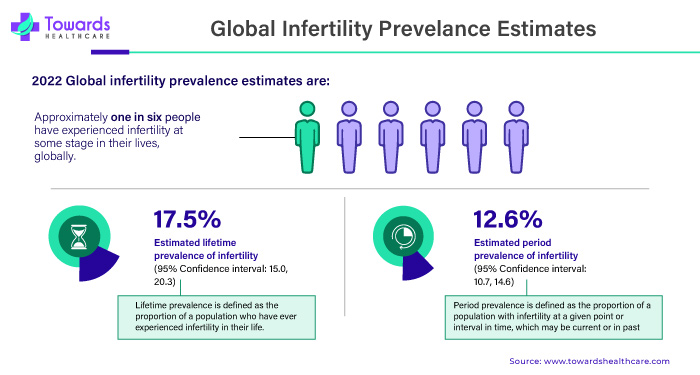
The rising prevalence of infertility has sparked a surge in demand for infertility treatment, thereby expanding the market for such services. This trend can be attributed to several factors. As more individuals and couples grapple with infertility, there is an amplified need for treatments to aid in conception. Consequently, clinics and healthcare providers have responded by expanding their services to accommodate the growing demand for assistance in overcoming fertility challenges.
Additionally, advancements in medical technology and assisted reproductive techniques have emerged in response to the escalating prevalence of infertility. These innovations have led to more effective and accessible treatments, attracting a more significant number of individuals to seek infertility treatment. Furthermore, the increasing awareness surrounding infertility issues and available treatment options has encouraged more people to pursue help for their infertility problems actively, further driving the growth of the infertility treatment market.
Lifestyle changes, such as delayed childbearing and environmental factors, have also contributed to the rise in infertility rates. As these factors persist, the demand for infertility treatments will remain high, sustaining the market's growth. In certain regions, government initiatives and insurance coverage for infertility treatments have played a pivotal role in enhancing accessibility to these services. This support has facilitated the expansion of the infertility treatment market by enabling a larger population to afford and access treatment. The escalating prevalence of infertility has spurred the growth of the infertility treatment market by fueling demand for effective and accessible solutions.
As infertility continues to affect a significant portion of the population, the market for infertility treatment is poised to continue its expansion to meet the increasing needs of individuals and couples seeking to overcome fertility challenges.
In vitro fertilization (IVF) has revolutionized how humans can have babies. Initially created to help couples who can't conceive naturally, IVF is now used for a broader range of medical and genetic issues, as well as for preserving fertility. While access to IVF varies worldwide, it's becoming more common, especially in places like Europe, where it's more affordable or covered by insurance. In some European countries, over 5% of babies are born through IVF. Similar trends are seen in Australia, New Zealand, the USA, and China, with IVF becoming more popular worldwide. Infertility, affecting around 10% of couples, is the main reason people turn to IVF. These trends suggest that IVF is likely to become even more common in the future, contributing to the growth of the infertility treatment market.
In vitro fertilization (IVF) is a big help for couples who can't have babies naturally. It's when eggs and sperm meet in a lab dish, and then doctors put the fertilized eggs into the woman's womb to grow. Many couples like this option because it gives them hope when natural ways don't work. Because more people want IVF, there are now more places where you can get it done, like fertility clinics and exceptional hospitals.
For instance,
Here are the delivery rates per transfer for different age groups:
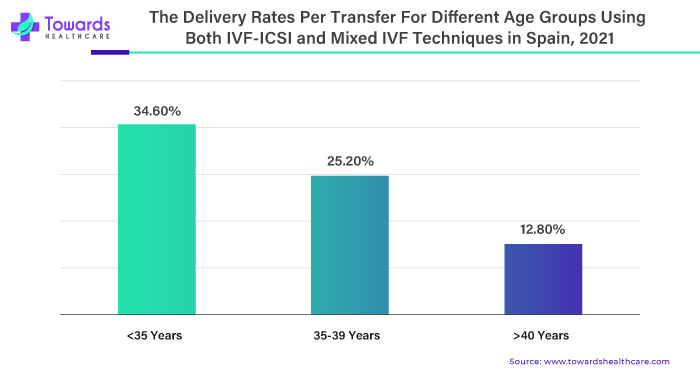
For instance,
Additionally, advancements in IVF technology have made the procedure more effective and accessible. Improved success rates and fewer complications have encouraged more couples to consider IVF as a viable option for starting a family. The widening scope of IVF indications has contributed to its popularity. Initially developed to help infertile couples, IVF is now used for various medical and genetic conditions, as well as fertility preservation for individuals undergoing treatments like chemotherapy.
IVF's affordability and insurance coverage also play a significant role in its increasing adoption. In regions where IVF treatments are more affordable or covered by insurance, more couples can access these services, leading to a higher demand for infertility treatment overall. IVF has not only provided hope to countless couples struggling with infertility but has also driven the growth of the infertility treatment market through its effectiveness, expanding indications, and increased accessibility.
Facing infertility can be very hard emotionally for people and couples. It's not just about physical struggles but also about feeling stressed and upset. Picture wanting something, but it seems impossible to get it no matter what you do. That feeling of not knowing and being let down can get you down, making it challenging to feel good and stay positive. When treatments don't work, it can feel like hitting a brick wall. Couples often experience a rollercoaster of emotions - hope, disappointment, frustration, sadness, and sometimes guilt or blame. The pressure to conceive can strain relationships, leading to arguments and misunderstandings.
On top of that, there's the constant worry about the future. Will we ever have children? What if we never do? These thoughts can consume a person, affecting their ability to focus on other aspects of their life, like work or social activities.
Support from friends, family, or a therapist can be crucial. Talking about feelings and fears can help lighten the emotional load. Some couples also find solace in support groups where they can connect with others going through similar struggles. It's important to remember that infertility doesn't define you or your worth as a person. Seeking emotional and medical help is a brave and essential step towards finding peace and resolution, whether that involves starting a family through other means or finding fulfillment in different aspects of life.
By product, the equipment segment held a dominant position in the infertility treatment market in 2023 and is estimated to grow at the fastest rate in the market during the forecast period. Different types of equipment are required for different functions during infertility treatment. Technological advancements and growing research and development activities lead to novel innovations in equipment, hence increasing its demand. The increasing number and demand for IVF and other procedures stimulate the use of equipment.
By procedure, the assisted reproductive technology (ART) segment dominated the market in 2023. ART is a set of all fertility treatments in which either eggs or embryos are handled. Out of all the ART procedures, in vitro fertilization (IVF) is the most prevalent procedure, accounting for 99% of the total ART procedures. Globally, more than 3 million ART cycles are reported annually. It is also highly preferred due to scientific advancements resulting in high success rates of such procedures.
By patient type, the female infertility treatment segment held the largest share of the market in 2023. Female infertility is a condition wherein a female is unable to get pregnant. It is estimated that around 30% of fertility problems originate in women. The increasing fertility rates in women due to ovulation problems, PCOS, etc., and the rapid advancements in infertility treatment drive the segment’s growth. The desire to conceive, reduce negative social impact, and address long-term fertility issues are some of the reasons for the treatment of female infertility.
By end-user, the fertility centers segment led the global infertility treatment market in 2023. The segment’s growth is attributed to the presence of skilled professionals, suitable infrastructure, and the availability of specialized equipment. The increasing number of fertility centers and an increasing number of patients in fertility centers also boost the segment’s growth.
The geographical landscape of the infertility treatment market in North America is also influenced by factors such as healthcare policies, insurance coverage, and regulatory frameworks. While insurance coverage for infertility treatments varies across states and provinces, efforts are being made to improve the accessibility and affordability of fertility care through legislative initiatives and advocacy efforts. In the United States, major cities such as New York, Los Angeles, Chicago, and San Francisco are known for their numerous fertility clinics and cutting-edge reproductive technology centers.
These urban hubs attract patients from across the country and even internationally, seeking advanced infertility treatments, including in vitro fertilization (IVF), intrauterine insemination (IUI), and genetic screening procedures. North America's geographical landscape for infertility treatment is characterized by a diverse network of clinics and healthcare providers, with a strong emphasis on technological innovation, patient-centered care, and improving access to fertility services across different geographical regions.
The U.S. is home to 371 SART member clinics that perform IVF procedures. In 2023, 432,641 IVF cycles were performed at these clinics, as per the American Society for Reproductive Medicine. The U.S. government is making constant efforts to increase the accessibility of infertility treatment and lower the cost of treatment, reducing barriers to IVF.
It is estimated that about 1 in 6 Canadian couples experience infertility. The Budget 2024 allocated $68 million over two years to support access to IVF, beginning in fiscal year 2025/26. The publicly funded IVF program will provide access to one-time funding, up to $19,000.
The geographical landscape of the infertility treatment market in the Asia-Pacific region is characterized by diverse factors impacting the availability, accessibility, and utilization of infertility treatments across different countries. In many countries within the Asia-Pacific region, there is a notable urban-rural divide in access to healthcare services, including infertility treatments. While major urban centers may have well-equipped fertility clinics and specialized facilities offering a wide range of treatments, rural areas may need more access to such services due to limited healthcare infrastructure and resources.
In the Asia-Pacific region, late marriages, growing infertility rates, rising disposable income, growing awareness about infertility treatments, and low-cost treatments increase the demand for infertility treatment. In India, around 2-2.5 lakh IVF cycles are conducted annually. While, in China and Japan, approximately 1.3 million and 0.6 million ART procedures were performed in 2022, respectively.
The Chinese government’s National Health Commission aims to establish one IVF facility for every 2.3 million people by 2025, amounting to a total of 600 facilities. The government is also planning to provide free fertility treatments to address the declining birth rate.
It is estimated that 10-15% of couples experience infertility in India, accounting for around 27.5 million infertile couples nationwide. There are around 2,500 IVF centers in India. Approximately 275,000 IVF cycles are performed in India annually.
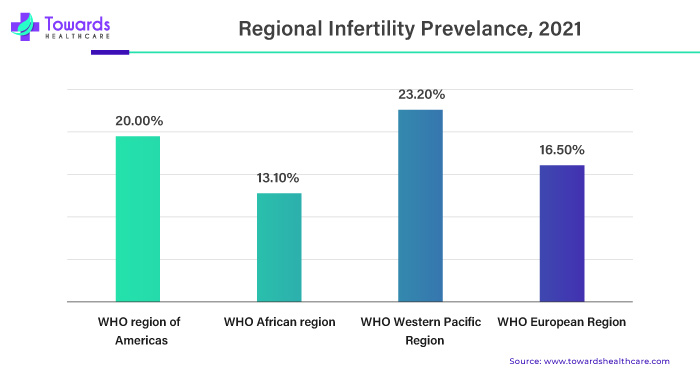
The competitive landscape of the infertility treatment market is characterized by a diverse range of players, including pharmaceutical companies, medical device manufacturers, fertility clinics, and healthcare providers. These entities compete based on technological innovation, treatment success rates, pricing, geographic reach, and patient satisfaction. Fertility clinics and ART centers offer a range of infertility treatments and services, including IVF, IUI, and fertility preservation. These facilities compete based on success rates, treatment options, patient experience, and pricing. Diagnostic laboratories offer a range of fertility testing services, including semen analysis, hormone testing, and genetic screening, to assess the underlying causes of infertility and guide treatment decisions.
Todd Watts, Co-Founder and CEO of PatientFi commented on its collaboration with EngagedMD that the partnership was formed to make fertility care more accessible and educate patients about their financing options. He also added that the average treatment cost of fertility treatment is around $12,000 to $15,000 per cycle but their company can act as a catalyst to remove financial barriers for both the clinics and the patients.
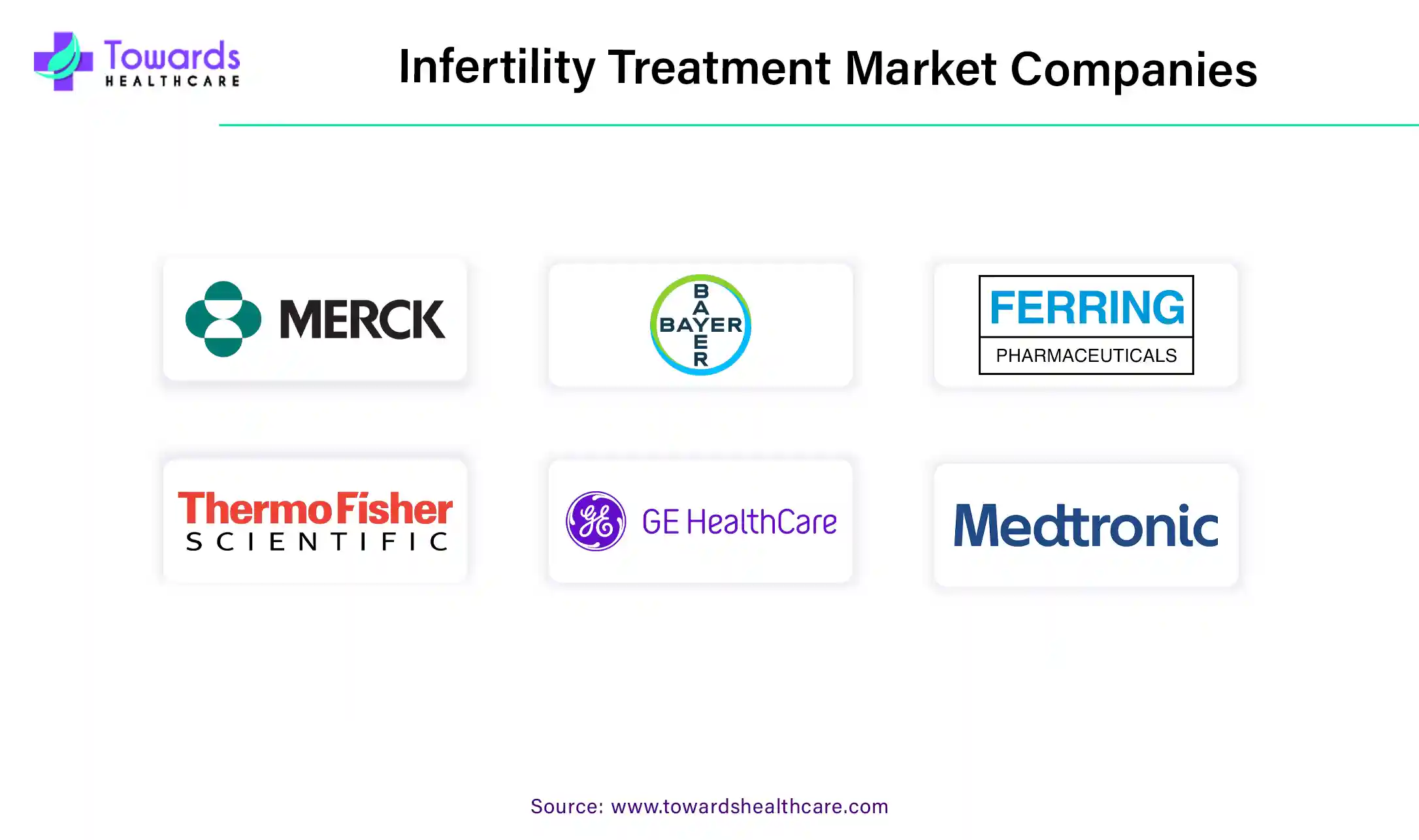
By Product
By Procedure
By Patient Type
By End-User
By Region
December 2025
December 2025
November 2025
November 2025